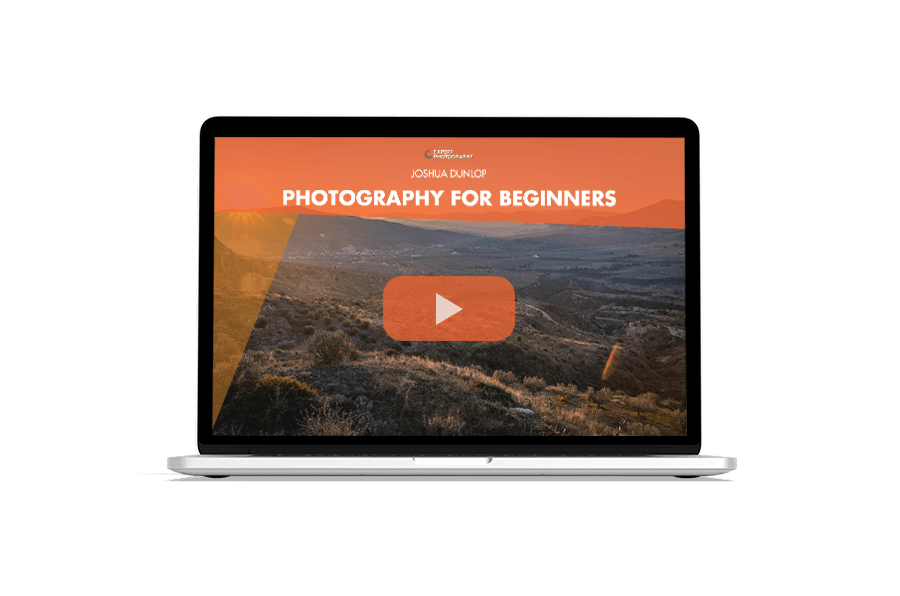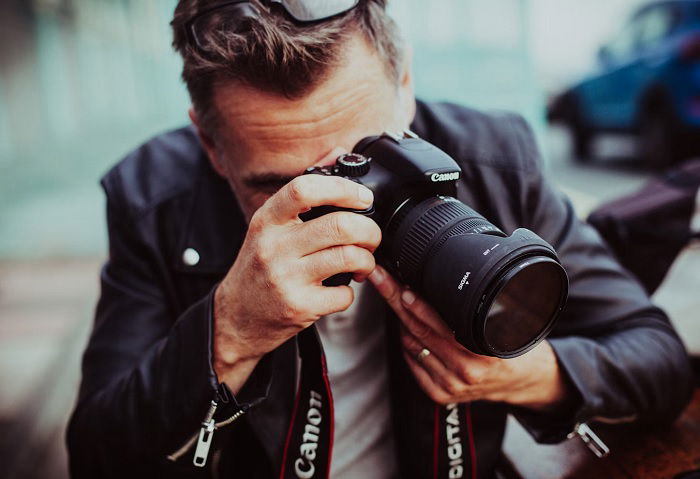Every photographer needs a basic understanding of crop factor. It’s something that comes up quite a lot in photography, especially when you’re buying a new camera or lens.
But what exactly is crop factor and why is it important in photography?
These are the questions we’re going to answer in this article. By the end, you’ll have a firm grasp of crop factor, sensor sizes, and equivalent focal lengths. You will know how all this affects your photography.

Crop factor is the change in field of view and magnification caused by pairing a lens with a “crop-sensor” camera.
A full frame sensor is the same size as a 35mm film cell from analog photography. We call it full frame because the frame remains full, or rather uncropped.
A camera lens projects a circular image. But while the edges of this round image are lost, the corners of a full frame sensor touch the edges of the full circle, thus still giving you a full frame.
An APS-C sensor, on the other hand, is smaller and the corners do not reach the edges of the full circular image. Much more of the image is cropped, which leaves you with a far narrower field of view.
Any sensor smaller than full frame is considered cropped and will experience crop factor. These include APS-C and Micro Four Thirds camera systems.
The result of crop factor is a narrower, more magnified field of view. Crop factor essentially changes the focal length of your lens, giving it a new “equivalent focal length.” This can have a big impact on how you use the lens and camera.
Don’t worry if this is starting to sound complicated. We’ll break it down and explain everything in the following sections.
An APS-C sensor is smaller than full frame and is therefore cropped. That’s why APS-C cameras are often called crop-sensor cameras. That’s also why these cameras experience crop factor.
Full frame sensors are standardized across all camera brands (36 x 24 mm). But the size of an APS-C sensor depends on the brand of camera you have.
Nikon, Sony, and Fujifilm all use APS-C sensors that measure 23.6 x 15.7 mm. Canon has a slightly smaller APS-C sensor that measures 22.2 x 14.8 mm.
The difference in size means they have different crop factor values. Nikon, Sony, and Fujifilm APS-C cameras have a crop factor of 1.5x, while Canon cameras have a crop factor of 1.6x
These crop factor values are important as they allow us to work out the equivalent focal length. This will tell you the field of view you can expect from your lens and crop-sensor camera.
Micro Four Thirds (MFT) sensors are even smaller than APS-C sensors, measuring only 17.3 x 13 mm. That means they experience an even higher level of crop factor.
Whereas APS-C sensors have a crop factor of 1.5x or 1.6x, MFT cameras have a crop factor value of 2.0x.
This makes a huge difference to the equivalent focal length, essentially doubling a lens’s focal length. And this happens even with lenses designed especially for Micro Four Thirds cameras.
Now we understand the basic grasp of what crop factor is and why it occurs. The next step is to look at how it effects photographers in a practical sense.
In order to do so, we need to look at focal length and equivalent focal length.
Every photography lens has a focal length, usually measured in mm. You will see this labeled on the front and/or side of the lens.
Technically, this measurement is the distance between the point of convergence in the lens and the camera’s sensor. The point of convergence is where the light beams converge within the lens.
So, if you have a 50mm lens, the point of convergence and sensor are 50 mm apart.
In practical terms, the focal length gives us an indication of the field of view produced by that lens. A 50mm focal length is considered standard, meaning it is neither wide nor narrow.
A smaller focal length, like 24mm, gives you a wide-angle field of view. You capture more of the scene in front of you, allowing you to capture broad scenes or confined spaces.
A 100mm focal length produces a telephoto field of view, which is narrower and more magnified than a 50mm lens. The more you increase the focal length, the narrower the field of view and the stronger the magnification.
When you use a lens with a full frame camera, the focal length stays the same. If your lens is labeled 50mm, you will get a 50mm field of view. That’s the same for a lens with any focal length.
But when you use a lens with an APS-C or Micro Four Thirds camera, the crop factor changes the effective focal length. The new focal length is called the equivalent focal length.
The equivalent focal length will be larger than the labeled focal length, with a narrower field of view.
It’s called the equivalent focal length because it is equivalent to a lens of that focal length on a full frame camera.
If we have a Nikon APS-C camera, we know it has a crop factor of 1.5x. This value is important as it allows us to calculate the equivalent focal length of the lens when paired with our Nikon APS-C camera.
We take the labeled focal length of the lens and times it by the crop factor. The equation is focal length x crop factor = equivalent focal length.
If we have a 50mm lens, this would be 50 x 1.5. The result is 75, meaning the equivalent focal length is 75mm. This equation works with any focal length.
But remember, Canon APS-C cameras have a crop factor of 1.6x. Therefore, our equation is 50 x 1.6 = 80. In this case, our equivalent focal length is 80mm.
We also need to understand this equation for Micro Four Thirds cameras, which have a 2x crop factor value. If we again use a 50mm lens, the equivalent focal length is 100mm (50mm x 2.0).
As long as you know the focal length of the lens and the crop factor value of your camera, you can work out the equivalent focal length.
The table below will help you understand equivalent focal lengths and necessary equations.
We’ve seen that camera’s come with different sized sensors. But we also need to understand that manufacturers also make full frame and crop-sensor lenses.
Nikon’s F-mount lens series has one of the most extensive catalogs of any lens collection. While most of them are full frame lenses, Nikon has made some special lenses for their crop-sensor cameras.
These are labeled with DX, while full frame lenses are FX. This is the same for their new Z-mount lenses for their mirrorless cameras.
Canon also has APS-C specific lenses, which are labeled EF-S for DSLR and RF-S for mirrorless.
Sony has a similar system, labeling APS-C lenses as E and full frame lenses as FE.
But even though these lenses are designed for different camera bodies, the cameras still have the same lens mounts. Therefore, you can use a Nikon FX lens with an APS-C camera and a DX lens with a full frame camera.
However, if you use a crop lens with a full frame camera, the image circle doesn’t fill the frame. The result is dark or black corners, meaning you’ll have to crop the image anyway.
The main problem with using full frame lenses on a crop-sensor camera is the crop factor. But you also need to be aware that you’ll still experience crop factor even if your lens is made for APS-C cameras.
Things are a bit more simple with Micro Four Thirds cameras. There are only two MFT manufacturers, Panasonic and OM System (formerly Olympus). And both brands use the same MFT (4/3) lens mount, so you can use Olympus lenses with Panasonic cameras and vice versa.
Panasonic does make full frame cameras, but these cameras have a different lens mount. But OM System only makes Micro Four Thirds cameras. You don’t have to worry about pairing a lens with the wrong sensor type.
However, you do need to remember MFT cameras have a 2x crop factor. The equivalent focal length is double the labeled focal length, which can completely change the purpose of a lens.
The biggest impact crop factor has on photography relates to focal length. As we’ve seen, crop factor completely changes the effective focal length of your lens.
This has massive practical implications for your photography. If you attach a 50mm lens but end up with a 75mm equivalent focal length thanks to the crop factor, your lens has transformed from a standard-angle lens to a telephoto.
50mm lenses are popular with street photographers, but they will struggle using a 75mm lens for candid shots in a cramped, urban environment.
The problem is even more acute with Micro Four Thirds cameras, as a 50mm lens becomes a 100mm lens. That’s a telephoto view that’s even narrower and more magnified.
This is why understanding crop factor and equivalent focal lengths is so important. It will affect every photo you take with an APS-C or MFT camera.
You also need to be aware of the different full frame and APS-C lenses. This also has a practical effect on your photography and how you take pictures.

Understanding crop factor is essential for anyone using an APS-C or Micro Four Thirds camera. It’s also beneficial knowledge if you have a full frame camera.
Crop factor changes the effective focal length of your lens, completely changing the lens’s purpose. It’s best to be fully aware of this before you start shooting, which is why you need to learn to calculate the equivalent focal length.
As with many topics in photography, crop factor can seem daunting and complicated. But as we’ve seen, the concept is quite simple once you understand what it is and how it affects you. Now you know about crop factor, you can make better decisions when using new cameras and lenses.

